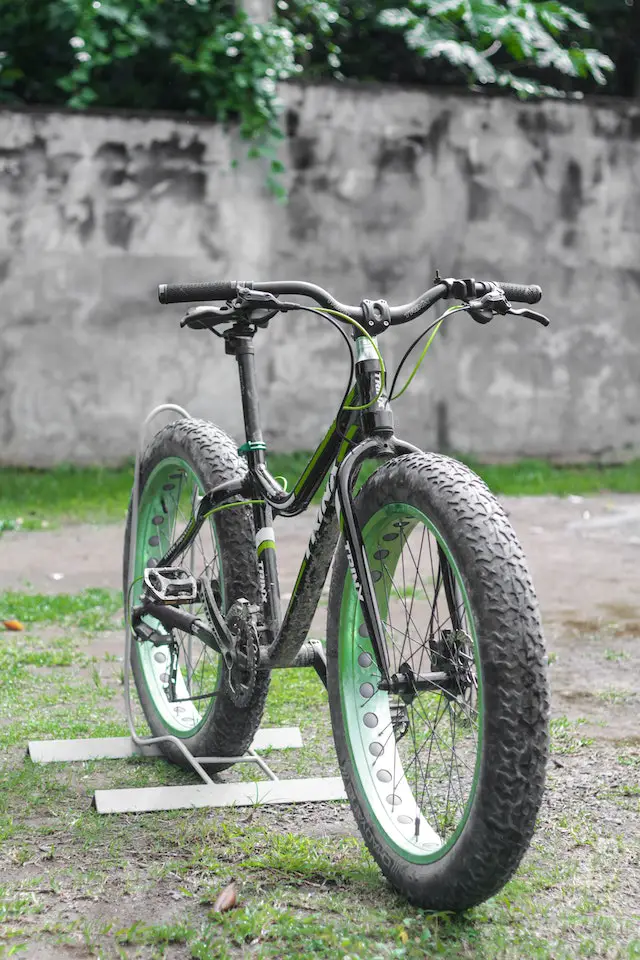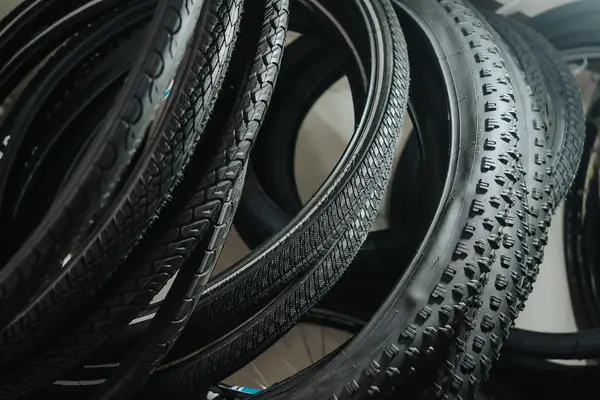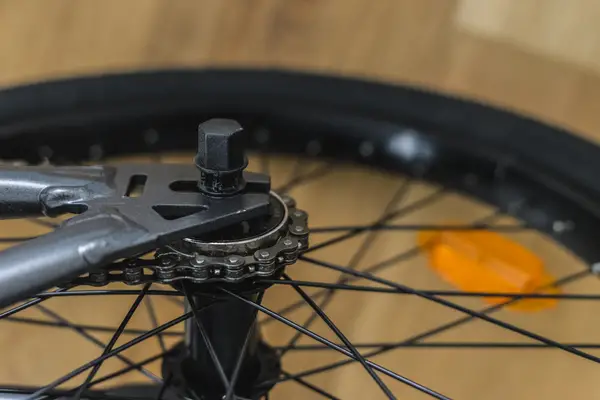If you’re a fan of fat bikes, you probably know they have wide fat tires, also known as fat tires, because they’re 4-5 inches wide.
On the other hand, mountain bikes feature tires that aren’t as wide. They range between 2 and 2.5 inches in width.
Many people prefer fat tires over regular ones because they can handle sand and snow. Unfortunately, you can’t fit fat tires onto any old regular bike. However, don’t lose hope. Maybe your type of bike can also accommodate fat tires.
Below, I will discuss different types of bikes that can run with fat tires. I will also share the pros and cons of having fat tires, suggest alternatives, and more, so let’s dive right in.
What are Fat Tires Typically?
Fat tires are extra wide bicycle tires that range from 4 – 5 inches wide.

As the name implies, they’re much wider and thicker than usual bike tires. Regular bike tires have a width of 2 inches, while fat tires range between 4 and 5 inches in width.
Moreover, fat tires have a different use than normal ones. Fat tires can handle rough terrains, such as snow, sand, etc.
Let’s compare fat tires with regular and plus-size tires and determine which type meets your biking needs.
How Do Fat Tires Differ from Regular or Even Plus Tires?

Fat tires differ from regular or even plus tires in size and use case.
- Fat tires (4 inches & over) are wider than regular and plus tires (2.5 & 3.5 inches).
- Fat tires also hold more air than regular (3x more than regular) or plus tires.
- Fat tires have more shock absorption than regular or plus tires.
- Fat tires have more traction than both regular and plus tires.
If you can’t decide between fat tires and plus-size tires, here’s a quick breakdown of the pros and cons of both types so you can make a well-informed choice.
So, Which One is Better?

For heavier people, fat tires make a better choice, as they make riding more enjoyable and comfortable.
Also, if your living area has rougher terrain or you plan to explore different landscapes (like snow, or sand) with your bike, I suggest buying fat tires.
However, plus-size tires will meet your biking needs if you use your bike to commute or explore surrounding flat trails.
In a nutshell, fat tires and plus-size tires generally look and perform the same. However, fat tires have more air, so they ensure more comfortable riding, while plus-size tires require less effort when climbing uphill.
Related: Fat bike vs MTB
So, Can You Put Fat Tires on Any Bike?

No, you can’t put fat tires on any bike. This depends on the bike type and suspension system. Also, the width of the fat tire must fit your bike frame.
If you have a mountain bike or your bike already has a bigger bike frame and good rim width, you can put fat tires on.
However, if it’s a bike with narrower tires for riding over paved surfaces, you can’t install fat tires on this type of bike.
To add fat tires to your regular bike, you should change the suspension and wheel size. Nevertheless, you should remember that regular bikes can’t handle the extra weight and stress.
Additionally, adding the wrong tires on the wrong type of bike can also damage the gear shifting system, brakes, or drivetrain.
What Types of Bikes Typically Accommodate Fat Tires?
Mountain bikes and other off-road bike types can accommodate fat tires, unlike regular bikes, as they already have bigger tires, frames, and suspensions that can handle fat tires. Also, these bikes have a tire diameter of over 26 inches, which is necessary for fat tires.

Fat tires weigh more than mountain bike tires and offer better tire tread. So, they make mountain biking, especially going uphill, more comfortable and much easier.
Also, fat bike tires increase the traction and stability of your ride and improve your maneuverability on rougher trails.
If your bike diameter is about 22-24 inches, you can’t put fat tires on it.
Can You Install Fat Tires on a Traditional Bike?
No, you can’t put fat tires on a traditional bicycle because fat tires require a larger diameter (over 26 inches). However, you can boost your regular bike’s tire width a little.

Standard bikes have a diameter of about 22-24 inches. So, they can’t accommodate fat tires. Plus, regular bikes can’t handle the fat tires’ additional weight and deliver the same stability as fat bikes.
If you’re determined to put fat tires on your regular bike, you must modify your bike. For instance, you should replace the frame with a bigger one that can accommodate bigger tires.
Also, you should adjust the suspension and brakes. Otherwise, the extra weight of fat tires will damage your bike’s brakes and other parts.
Lastly, if you don’t modify your regular bike before installing fat tires, you will experience wobbling and lose control when riding.
Can You Add Fat Tires on a Road Bike?
No. You can’t transform a road bike into a fat tire mountain bike.

However, you can add wider tires onto a road bike and increase your bike’s tire width.
Wider tires get closer to the ground and don’t buckle on rougher terrains. So, you can ride your road bike on different terrains by installing wider tires.
To install wider tires on your road bike, you must match the diameter of wider tires with that of your road bike. Most road bikes have a diameter of about 24 inches. So, you can put wider tires with a diameter of about 24 inches.
You must modify your road bike to fit wider tires to add fat tires.
Why Put Fat Tires on a Bike?
Most people use fat tires during winter because these tires offer a better grip on ice and snow. You can also use them for heavy off-road riding, as they provide better traction. Fat tires also make riding more comfortable.
Overall, they work great for exploring different terrains. They’re made with comfort in mind. Lastly, they’re perfect for beginners, as they offer better balance and stability than slimmer tires with less grip on various terrains.
Cons of Using Fat Bike Tires
Here’s a list of other minor inconveniences of fat tires you should know.
Heavy
Fat tires make bikes heavier and slower, so their weight is one of their downsides.
Expensive
Also, they’re more expensive than regular bike tires.
Slow on Road
Fat tires operate great on rough terrains, but if you use them on smooth ground, they are a much slower ride. Their grip increases the rolling resistance, so you will have to work hard to get your bike moving on pavement.
You Must Monitor Tire Pressure Closely

If you have fat tires, you should constantly control the tire pressure.
The tire pressure of these tires determines how the bike interacts with the ground more rigorously than a regular tire.
If the PSI is too high, you will have a bumpy and uncomfortable ride. On the other hand, if it’s too low, you risk ruining your rims.
Also, fat tires require extra pedaling effort. That’s great news for your body because you exercise more while riding your bike. However, they make commuting harder.
They Take More Storage Space
Fat tires take up more space than standard tires because they’re bigger and make bikes heavier. So, storing them can become challenging if you live in a smaller home.
How to Put Fat Tires on a Bike?
The installation process of fat tires depends on your bike type and current setup.
If you plan to replace the tires on your mountain bike, here’s a quick guide on how to do it correctly.
Inspect Your Bike’s Parts
First, look at the rim, the wheel’s outer edge that holds the tire in place.
Second, check the fork made of 2 blades joined at the top that holds the front wheel.
Third, examine the chain stay made of metal tubes on the back of your bike’s frame that locks the rear axle in place with the bottom bracket.
You can replace your regular tires with fat tires with small adjustments. The fork should have enough width between the 2 blades for your fat tires.
Upgrade Your Current Setup
If your bike can’t fit fat tires, you should upgrade your current setup.
First, buy new rims that handle wider tires and a wider fork. You should also change the chain stay if the new tires affect the operation and stability of the chain.
Avoid buying cheap parts. Otherwise, you will have bad results. I suggest purchasing a strong carbon fork for the best results.
You will experience a much smoother ride with a high-quality fork and no vibrations.
If you think you can’t handle the conversion of your fat tire bike, ask a professional for help. Otherwise, you risk ruining your bike.
Things to Consider Before Getting Fat Tires for Your Bike
If you’re interested in buying fat tires for your bike, here’s a list of factors to keep in mind before making a purchase.
Diameter
Older models of fat bikes feature 27-inch diameter wheels and tires. On the other hand, newer ones use 27.5-inch diameter wheels and tires.
However, some newer models could fit 26-inch diameter rubber. Stick with the diameter that already works for your bike.
Fat Bike Tire Width
It would be best to use tires as wide as a fat bike’s manufacturer recommends because tires that don’t fit can be hard to return.
The width also represents the height of a tire, so choose carefully because a big jump in size might feel more stable but also put pedals very close to the ground.
Extra Tip: Typically, the width of rims/wheels is measured in millimeters, while the width of tires is represented in inches.
Terrain
If you plan to use fat tires during winter, I suggest purchasing the ones with studs. On the other hand, studs shouldn’t play a role in your purchase if you’re buying tires for riding in the sand.
Can I Put Fat Tires on Any Bike: Conclusion
You can put fat tires on most mountain bikes. These tires will add versatility to your bike because you can use your mountain bike in the snow, sand, mud, etc.
However, you can’t add fat tires on any bike, especially regular bikes because they can’t accommodate wider tires.
Installing fat tires on a traditional bike can cause major damage.


